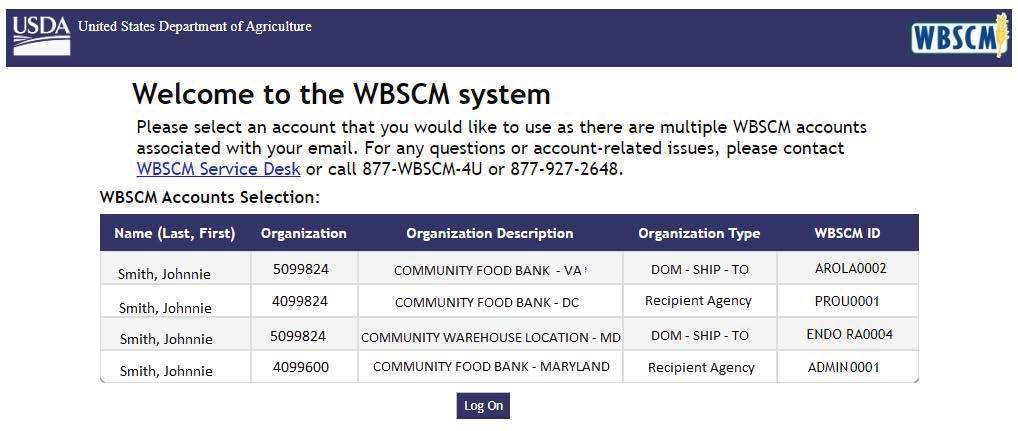|
The USDA Foods team is excited to resume the USDA Foods from Farm to Plate e-letter to provide stakeholders with monthly updates and information about all of our USDA Foods programs. We would like to acknowledge that the stakeholders and partners who subscribe to these e-letters have no-doubt been experiencing changes in program operations and challenges during these unprecedented times. Like you, our staff has been busy responding to the critical needs of our USDA Foods programs and we have many updates to share about our efforts since March.
This edition of the e-letter will provide high-level USDA Foods program updates on:
- The Food Distribution Program on Indian Reservations (FDPIR)
- Household Programs: The Commodity Supplemental Food Program (CSFP) and The Emergency Food Assistance Program (TEFAP)
- USDA Foods in Schools
- Web Based Supply Chain Management (WBSCM)
Please scroll to your program(s) of interest below. We plan to resume our normal rotation of program-specific e-letters in October with more detailed articles pertaining to the topics mentioned below.
FDPIR Program Updates
FNS has recently released two memoranda regarding the ongoing coronavirus response. On April 27, 2020, FNS released the “Food Distribution Program on Indian Reservations (FDPIR): Request for Funding for Facility Improvements & Equipment Upgrades to Prevent, Prepare for and Respond to Coronavirus Challenges”. This memorandum announced the allocation of $50 million for facility improvements and equipment upgrades for Indian Tribal Organizations (ITOs) and State Agencies that administer FDPIR for program costs allowable under the law.
On May 7, 2020, FNS released “FD-148: Questions and Answers related to COVID-19 and the Food Distribution Program on Indian Reservations (FDPIR)”, which included questions and answers on flexibilities to Indian Tribal Organizations (ITOs) and state agencies on the operations of FDPIR. These flexibilities may assist ITOs and state agencies that administer FDPIR in continuing to provide food to people in need during the novel COVID-19 public health emergency.
The October "FDPIR Connections" edition of the USDA Foods e-letter will provide more specific FDPIR program updates.
FDPIR and the 2020 Census
USDA FNS is partnering with the U.S. Census Bureau to encourage participation in the 2020 Census and to ensure tribal communities are accurately represented. The Census Bureau's tribal affairs office has been in contact with the FDPIR directors and are offering 2020 census tote bags and a half page flier for use in food distributions with tribal nations.
The census counts everyone in the United States. Census results are the basis for congressional representation and help determine how more than $675 billion in federal funds is distributed each year to support vital programs in states and communities across the country. These funds shape local health care, hospitals, housing, employment, and public policy. Specifically, the U.S. Census Bureau is providing FDPIR administering agencies with informational materials (i.e., pamphlets and tote bags) for distribution with FDPIR benefits between August and October 2020. The fliers include information on the importance of being counted as a tribal citizen, the website address for online completion of the form, and the phone number for additional information.
Additional resources and information can be found at the 2020Census.gov Tribal Resources webpage.
The Commodity Supplemental Food Program and The Emergency Food Assistance Program
Over the past few months, FNS has published memoranda to help deal with the unique situations caused by the novel Coronavirus along with a few routine memoranda. Below are brief summaries of recently published memoranda along with links to the full memorandum.
On March 11, 2020, FNS published “TEFAP – Farm to Food Bank Projects State Plan Requests and Fiscal Year (FY) 2020 Allocations”. This memorandum provided State agencies with information on how to apply for TEFAP Farm to Food Bank Projects in FY 2020. A summary of FY 2020 projects can be found at this link.
On April 24, 2020, FNS published “TEFAP: Allocation of Coronavirus Aid, Relief, and Economic Security Act Supplemental Appropriations”. This memorandum explains the details on the $450 million in supplemental funding provided by the Coronavirus Aid, Relief, and Economic Security Act (PL 116-136, CARES Act).
On May 22, 2020, FNS published “FD-149: Questions and Answers related to COVID-19 and the Emergency Food Assistance Program (TEFAP)”. This memorandum includes questions and answers on flexibilities available to TEFAP state agencies to help provide food to people in need during the novel COVID-19 public health emergency.
On May 22, 2020, FNS published “FD-150: Questions and Answers related to COVID-19 and the Commodity Supplemental Food Program (CSFP)”. This memorandum includes questions and answers on flexibilities available to CSFP state agencies, including Indian Tribal Organizations. These flexibilities may assist State agencies that administer CSFP in continuing to provide food to seniors in need during the novel COVID-19 public health emergency.
On June 12, 2020, FNS published “TEFAP Policy Memorandum: Additional Information on FY 2020 Funding Sources for TEFAP”. This memorandum provides overview information on the various sources different sources of TEFAP funding available this year.
Look to upcoming editions of our Household Highlights e-letter for additional program updates on CSFP and TEFAP.

CSFP Webinar Recordings
In case you missed it, FNS hosted two CSFP webinars in July. On July 23 FNS hosted a CSFP 101 webinar for state and local agencies that provided a brief history of CSFP, allowable uses of administrative funds, and policy basics. Attendees also received an overview of CSFP income eligibility standards and policies for distributing the CSFP food package. The webinar recording can be viewed at this link.
On July 28 FNS hosted The Enhanced CSFP Food Package: Where are We Now? which, focused on the food package enhancements and how to successfully manage inventory to adjust for client preferences, logistical challenges, and inventory shortfalls. We provided an overview of the new foods that have improved the food package and reviewed the inventory ordering tool to help states and local agencies adjust to changing needs based on client feedback. The webinar recording can be viewed at this link.
|
Child Nutrition Waivers and Flexibilities in Response to COVID-19
In response to the change in circumstances brought about by the COVID-19 pandemic, FNS issued a number of waivers and flexibilities for Child Nutrition programs. These waivers adjust some of the regulations, policies, and program operations to ensure students can receive food despite school closures and social distancing guidelines.
Click this link for a full list of Child Nutrition COVID-19 waivers and flexibilities.
Click this link to view Child Nutrition waivers and flexibilities by State.
We encourage you to regularly check these links for updates related to adjusting Child Nutrition regulations and policies in response to COVID-19.
 Entitlement Waiver
Due to widespread school closures resulting from COVID-19, there is a potential that reimbursable lunch counts will be reduced in many States across the country. These reductions may result in decreases to the USDA Foods entitlement available to some State Distributing Agencies for school year (SY) 2020-2021, which could lead to fewer USDA Foods provided in school meals.
To address this potential reduction, FNS published a waiver in June which allows State Distributing Agencies to choose to use SY 2018-2019 lunch counts for their SY 2020-2021 preliminary entitlement. All participating States and Territories have opted-in to this waiver. More information on the Opt-In Waiver for School Year 2020-2021 National School Lunch Program USDA Food Entitlement Calculations Waiver can be found here.

USDA Foods in Schools Webinar Recordings
On July 30, FNS hosted a webinar for State Distributing Agencies who manage USDA Foods in Schools programs. It's a New School Year: What's Happening with USDA Foods in Schools provided guidance on the USDA Department of Defense (DoD) Fresh Fruit and Vegetable Program and National Processing Program. We covered updates on allocating funds and adding new sites to USDA DoD Fresh, monitoring USDA Foods inventories, and details on SY 2020-2021 entitlement calculations, including the Families First Coronavirus Response Act (FFCRA) Opt-In Waiver for School Year 2020- 2021 National School Lunch Program USDA Foods Entitlement Calculations. The webinar recording can be viewed at this link.
On September 3, FNS hosted a USDA Foods in Schools webinar entitled COVID-19 Guidance for Managing USDA Foods Inventories in SY 2020-2021. This webinar provided guidance on flexibilities available to help manage USDA Foods in Schools during these unprecedented times due to COVID-19. Topics included information on USDA Foods direct delivered products, USDA Department of Defense (DoD) Fresh Fruit and Vegetable Program, and the National Processing Program. We covered some actions you can take to assist with utilization of USDA Foods inventories and minimize food loss. This webinar was intended for State Distributing Agency and FNS Regional Office staff who manage USDA Foods in Schools programs. The webinar recording can be viewed at this link.
|
Changes to USDA eAuthentication
The eAuth User ID serves as the login for Web-based Supply Chain Management (WBSCM), Fresh Fruit and Vegetable Order/Receipt System (FFAVORS), and Integrated Food Management System (IFMS). In June, USDA eAuthentication (eAuth) NextGen was implemented for these computer applications.
All new eAuth IDs require a unique email address, which will serve as the User ID. Users must be able to access this email to complete the registration process and use the self-service tool.
Existing eAuth IDs have not changed, including those that share the same email address. Legacy users can add a unique secondary Account Management Email to their eAuth profile to make use of streamlined self-service features.
The eAuth website offers a brand-new look, improved user experience, and several self-service features, including:
- Create a new eAuth ID within a few minutes after entering a unique email address. New users will receive a link via email to complete the registration process.
- Online identity verification via Experian, minimizing the need to visit a USDA Service Center. If required for their level of access, users will be instructed to complete this process.
- If the eAuth password needs to be reset, users with a unique email address will receive a reset link. Users without a unique email address will need to respond to the security questions they selected when registering.
For general help with creating or managing the eAuth ID, an FAQ is available. For specific guidance regarding access to the food distribution applications and user account management, refer to help documentation and registration processes for that application.
Highlights from Recent WBSCM Releases
Web-based Supply Chain Management (WBSCM) is under continuous improvement for maintenance and quarterly enhancements. A summary of recent changes for each release can be found at Help > Training > Release Notes.
In June, WBSCM updated to eAuthentication (eAuth) NextGen for login management. Existing users will continue to use the same eAuth ID. New accounts may be linked to an existing eAuth ID or to a new one (as long as the last name and email address match). For users who maintain multiple WBSCM accounts, new accounts can be linked to the same eAuth ID. After logging in, they will be prompted to select from a list of WBSCM user accounts linked to that eAuth ID. Accounts previously linked to different eAuth IDs cannot be consolidated. To support users, new training materials and a registration tutorial video are now available.
 The August release introduced the ability to cancel a goods receipt that was entered in error, such as on the wrong Purchase Order (PO) line. This process is explained in the new Cancel Shipment Receipt work instruction. This function is currently only available for PO lines without an Advance Shipping Notification (ASN) number. If the ASN was entered, users may still modify the receipt but cannot cancel it without WBSCM Service Desk assistance.
 To support the Business Management Improvement (BMI) project, new WBSCM features to support the USDA Foods Processing Program are being piloted for the SY21 bulk potato orders. The July release provided FNS with the ability to convert the demand forecast (orders) to a scheduling agreement with Processor plants. The September release will include updates to reports as well as support for pilot Processors to allocate received materials by State for tracking purposes.
Did you know you can track your WBSCM issues and questions online via the WBSCM Service Desk Portal? Refer to the new Create and Manage a WBSCM Incident job aid to learn how.
If you have any questions, please contact the WBSCM Service Desk or call (877) 927-2648.
FFAVORS Access and eAuth NextGen
With the Release 2.12 in June, the Fresh Fruit and Vegetables Order Receipt System (FFAVORS) now utilizes USDA eAuthentication (eAuth) NextGen for login management.
The email address associated with the eAuth profile must match the email address in FFAVORS each time the user logs in. If the email address in FFAVORS is changed and/or if a new eAuth ID is created with a different email address, access to FFAVORS will be impacted.
Users with more than one FFAVORS profile can now use the same eAuth ID to access multiple profiles as long as the email address is the same. After logging in, users will be prompted to select from the active FFAVORS profiles associated with that email address. To switch to a different profile without logging out, a new Switch link is available at the upper right corner of screen.
 When logged in, users can check for important news about FFAVORS in the Announcement box on the home page. To view or download the latest version of the manual, click the Help link at the upper right corner of the screen. If you have any questions, please contact your FFAVORS account representative or email the FFAVORS Help Desk.
System Reminders
-
09/24/2020: WBSCM Release (2020R4.3.09)
-
09/30/2020 at 4:00 p.m. EDT: WBSCM End-of-Year Closeout
- No access to receipting and procurement activities
-
10/01/2020 at 4:00 a.m. EDT: WBSCM Functionality Restored
-
10/04/2020: FFAVORS Release (2.13)
-
11/24/2020: AIS Release (12.2020)
Planned dates for system activities are subject to change.
|